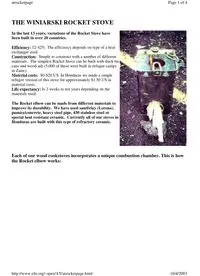
Winiarski Rocket Stove 2003 PDF
Preview Winiarski Rocket Stove 2003
THE WINIARSKI ROCKET STOVE In the last 13 years, variations of the Rocket Stove have been built in over 20 countries. Efficiency: 12-42%. The efficiency depends on type of a heat exchanger used. Construction: Simple to construct with a number of different materials. The simplest Rocket Stove can be built with thick tin cans and wood ash (5,000 of these were built in refugee camps in Zaire). Material costs: $0-$20 US. In Honduras we made a simple refugee version of this stove for approximately $1.50 US in material costs. Life expectancy: Is 2 weeks to ten years depending on the materials used. The Rocket elbow can be made from different materials to improve its durability. We have used sand/clay (Lorena), pumice/concrete, heavy steel pipe, 430 stainless steel or special heat resistant ceramic. Currently all of our stoves in Honduras are built with this type of refractory ceramic. Each of our wood cookstoves incorporates a unique combustion chamber. This is how the Rocket elbow works: Page 1 of 4 atrocketpage 10/4/2003 http://www.efn.org/~apro/AT/atrocketpage.html Page 2 of 4 atrocketpage 10/4/2003 http://www.efn.org/~apro/AT/atrocketpage.html This elbow is then placed inside of a container that is filled with insulation . The container can be made from almost any material. We have used 5 gallon drums, brick, clay, cement. For insulation we suggest using wood ash or pearlite, or pumice,. Do not use massive things such as earth, sand,or cement. These will rob heat from the stove and reduce your combustion efficiency. For optimal use we recommend a 9" chimney and a 4" fuel feed magazine. The Rocket stove is an improvement over the three stone fire but it is only one part of the equation. In order to really save fuel wood we must maximize the heat transfer to the pot. Page 3 of 4 atrocketpage 10/4/2003 http://www.efn.org/~apro/AT/atrocketpage.html This picture shows a thin piece of metal (a skirt) wrapped around the pot. This skirt forces the hot flue gases to rub against the bottom and the sides of the pots. The gap between the pot and the skirt should be about 1cm (assuming you are using an average-sized pot). In our tests, this simple heat exchanger (an old coffee can works well!) almost doubles the efficiency of the rocket stove. Back to Stove Page | Back Home Page 4 of 4 atrocketpage 10/4/2003 http://www.efn.org/~apro/AT/atrocketpage.html
